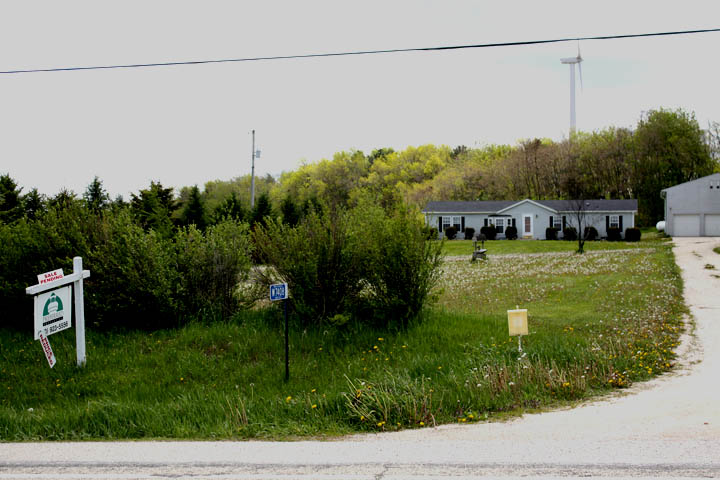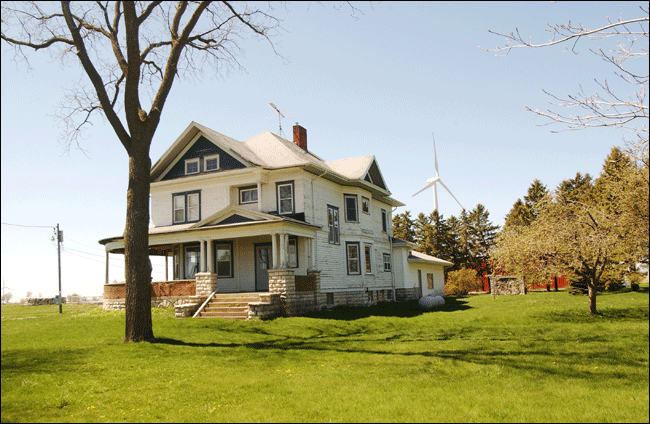Entries in wind farm complaints (77)
9/19/10 What part of 'conflict-of-interest' don't you understand?
Note from the BPWI Research Nerd: The story below outlines a problem that comes with wind development everywhere, including Wisconsin, where wind projects have been approved and permitted by members of local government who stood to gain financially from the project or had family members who would.
Although some members of the Wind Siting Council saw the conflict of interest issue as a problem that should be directly addressed in the wind siting rules, the majority of the council-- most of whom happen to have a direct or indirect financial interest in the outcome of the rules-- decided against including it.
Records show area officials profit
from leases with turbine firms
SOURCE: Observer-Dispatch, www.uticaod.com
September 18,2010
By JENNIFER BOGDAN,
Twelve public officials who sat on county and town boards in Lewis County stand to make a combined $7.5 million from the region’s largest wind-turbine project, government disclosure forms show.
And numerous other officials in Herkimer County stand to profit as well from new projects there, although not to the same extent, records show.
The lease arrangements have raised questions among local residents and good-government experts about potential conflicts of interest as wind-turbine farms are approved.
One person who feels that way is Gordon Yancey of the town of Lowville, who used to have a clear view of the Adirondacks stretching as far as the eye could see from his property on the edge of the Tug Hill plateau.
But in 2006, the sprawling Lewis County landscape became home to the Maple Ridge wind farm – a group of 195 wind turbines towering 400 feet high over the once undeveloped landscape in Lowville, Martinsburg and Harrisburg. Those communities are located along state Route 12 about one hour north of Utica.
Now, Yancey said all he sees are the massive white towers obstructing his view. He blames lease agreements between wind developers and public officials, one of whom is his brother, Edward Yancey, who sat on the Harrisburg Zoning Board of Appeals.
Edward Yancey stands to benefit to the tune of up to $1 million over the lifetime of the agreement, according to disclosure forms filed with the state by Iberdrola Renewables and Horizon Wind Energy, which co-own the project.
“They made their sweetheart, backdoor deals long before anything was made public,” Gordon Yancey said. “Of course, the boards pushed everything through.”
Edward Yancey could not be reached.
Disclose or face fine
A 2008 mandate from the state Attorney General’s Office requires wind companies to disclose the nature and scope of any municipal officer’s financial interest in a wind project or risk facing fines of as much as $100,000.
No companies have been penalized to date, according to the state Attorney General’s Office.
“In order to avoid even the appearance of impropriety, we publically disclose any relationship with a municipal officer or their relative,” Iberdrola spokesman Paul Copleman said.
Lise Bang-Jensen, senior policy analyst for the Empire Center for New York State Policy, said any move towards increased government transparency is admirable, but making sense of conflicts is more complex than writing them down.
“If you have a role on both sides of a project, that’s a clear conflict of interest,” Bang-Jensen said. “Putting it on a piece of paper and disclosing it, doesn’t make it legal.”
Many of the officials listed on the disclosure forms – including Harrisburg Town Supervisor Stephen Bernet, who stands to make $1 million – did not return calls last week.
One of those listed on the disclosure forms is Roger Grace, a Planning Board member in Pinckney. Maple Ridge wind farm spreads across Lowville, Harrisburg and Martinsburg, but Grace, who stands to make as much as $20,000 from the project, still is required to disclose his role in a neighboring town.
He said his role isn’t a concern, and he believes those involved have acted appropriately.
“I think everyone’s done a phenomenal job,” Grace said. “It’s always a battle, though. People that got money love them, and people that didn’t get money hate them. That’s all.”
‘Not acting objectively’
The issue of lease agreements between public officials and wind developers is burgeoning in Herkimer County, where the Hardscrabble wind farm is slowly rising.
The Herkimer County towns of Fairfield and Norway will soon be home to 37 turbines – seven of which are already standing.
In that project, five officials stand to make as much as $85,000 from the turbines that are expected to be up and running by the end of the year.
“For any municipal officers or their relatives with whom we have a relationship, we specifically request that the officers recuse themselves from a decision or vote that would in any way affect the development of a project or affect how the municipality treats wind power,” said Copleman, the Iberdrola spokesman.
Yet six years ago, when the Hardscrabble project was nothing more than a vague concept, questions arose as to why Fairfield Planning Board member Harold Robinson was voting on wind issues while he had an agreement with the wind company aiming to come to town, according to O-D archives.
“The Town Board is not acting objectively,” Fairfield Planning Board Chairman Peter Fishbein complained in 2004. “The board needs to acknowledge there are people who are worried about this and at least hear their concerns.”
Robinson, who stands to make as much as $20,000 from a lease agreement, did not return calls last week.
‘Won’t like the looks of things’
Other wind projects are brewing across the Mohawk Valley, including a plan from NorthWind and Power to build a farm of eight to 12 turbines on Dry Hill in Litchfield.
In that development, some residents have questioned the role played in the process by Litchfield Supervisor Wayne Casler, He is a regional controller at Barrett Paving Materials, which owns more than 100 acres of land on the southern end of Dry Hill.
Wind developers have said the paving company’s land won’t be considered, but the company could be chosen to supply materials for the project if it’s approved.
From time to time in Lowville, Gordon Yancey hears rumblings of other wind farm in the works – like the one in Litchfield.
Each time, he said, he thinks back to the days before his business was surrounded by turbines. Oftentimes, the curious come knocking on his door to ask what his experience was like years before.
“What I tell people is ‘Educate yourselves because you can’t trust where anywhere else is coming from,’” Yancey said. “Ask every question you can. And when you do, you won’t like the looks of things either.”
10/14/10 On being a red square in a yellow circle: A wind siting council member weighs in on the real cost of Wisconsin wind farms AND Wind Turbines Too Loud? Sorry Charlie, ain't a lot we can do for you now.
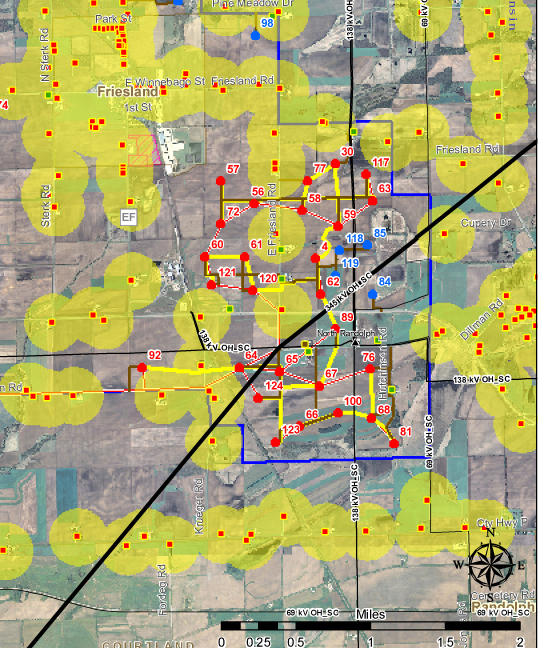
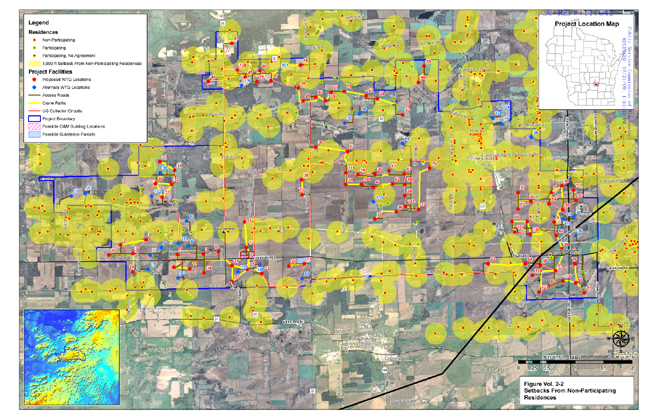
HOW MANY RESIDENTS WILL BE AFFECTED BY THE NEW WIND SITING RULES?
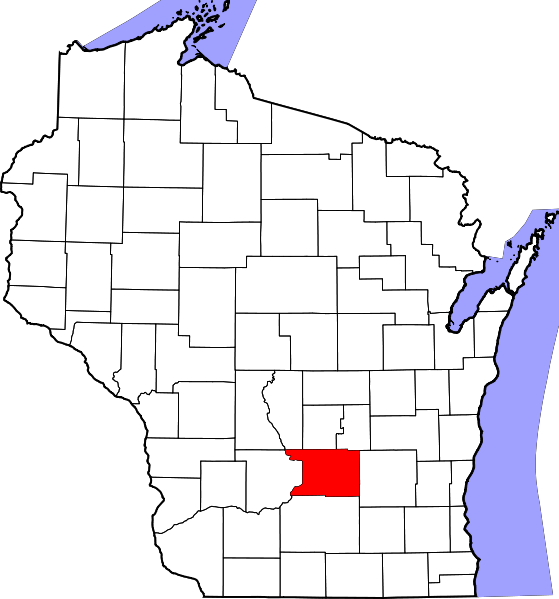
The red squares in the yellow circles on the map above represent non-participating homes in the WeEnergies Glacier Hills wind project currently under construction in Columbia County.
The larger red dots are the turbine locations. [Scroll down to see more detailed maps.]
The new wind rules adopted by the Public Service Commission have the same setbacks from homes as were used for this project.
One difference is the PSC required WeEnergies to offer to buy two homes in the project because seven turbines were to be located within half a mile.
The new rules do not include this sort of protection. Chairman Eric Callisto said by law homeowners have the right to sue the wind developer/owner and he felt that was all the protection they needed.
Although Wisconsin wind farm residents who have been forced to try to sell their homes because of turbine noise and shadow flicker have found no buyers, local wind developers say 400 to 500 foot tall wind turbines located less than 1500 feet a home have no impact on property values.
[CLICK HERE to watch Wisconsin Eye video: During the panel discussion, WPPI vice president Dan Ebert and WeEnergy's head of wind development Andy Hesselbach explain why turbines do not affect property value. ]
Or CLICK HERE to link directly to the Wisconsin Eye 'Newsmakers' feature "Future of Wind Energy"
Developers also say Wind energy is the cheapest way to get renewable energy and cite surveys which indicate stong public support for wind power.
Wind siting council member and Wisconsin realtor Tom Meyer weighs in on the matter.
This is not a question of whether or not people like, or favor "wind" as the lobbyists try to argue. Everyone likes wind, sun, water, earth.
The issue is this: The total cost of generating energy by the use of 400 and 500 foot tall turbines in Wisconsin’s rural communities.
Developers admit that they cannot get investors, who are primarily foreign investors, to put their money up unless the costs of access to the land are depressed.
To get the biggest area to install the highest number of 400 to 500 foot tall turbines, the developer needs to have the greatest access to the most land and compensate the fewest people with the least dollars.
The developer does not need your land, he needs to get one foot [away] from your land.
Every foot the developer is made to move away from a landowner whom he does not have to compensate, adds cost to the developer and reduces the bottom line to investors.
Every dollar spent to gain access to the right to disturbing the peace of a landowner reduces the bottom line.
For wind turbines to be profitable, the industry could improve the technology or depress the cost of access to the land.
By their actions, they prove they believe depressing land costs is more favorable than investing in improving the technology.
Their answer to improved technology is taller and more intrusive. That's not a real solution.
If the turbine can't produce energy without imposing on neighbors, there is no reason to spoil the earth, and threaten the water, and block the sun, to catch the wind.
-Tom Meyer
Wisconsin Wind Siting Council Member
NOTE: Tom Meyer was one of the authors of the minority report from the wind siting council. The report details why some council members strongly disagree with the recommendations sent forth to the Public Service Commission.
CLICK HERE to download pictures of homes in Wisconsin wind projects.
Below, detail maps of non-participating residences in WeEnergies Glacier Hills Project
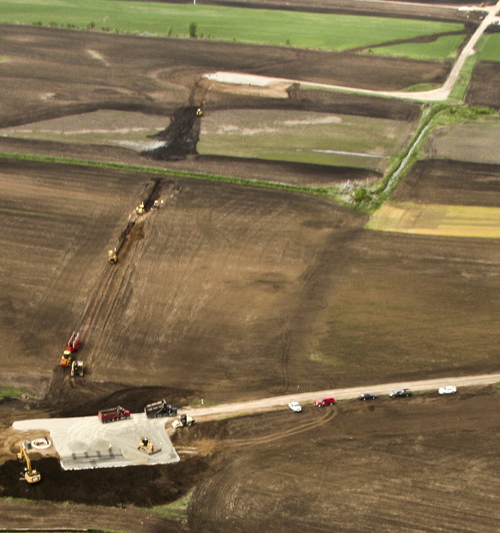
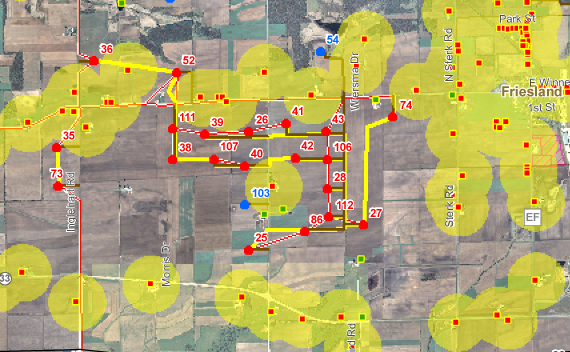
NOTE FROM THE BPWI RESEARCH NERD:
The project mentioned below was sited with the same setbacks and noise limits used to site the We Energies Glacier Hills project. (Detail maps above)
NO EASY SOLUTION TO WIND TURBINE PROBLEM
The Associated Press
VINALHAVEN, Maine (AP) -- The CEO of the electric cooperative that installed wind turbines on Maine's Vinalhaven island says there's disagreement over data suggesting they're too noisy. Fox Island Wind CEO George Baker says his experts dispute the findings of a Department of Environmental Protection consultant who says the turbines violate nighttime noise limits. State law sets a 45-decibel limit. Baker says his experts believe it was ambient noise from wind rustling through trees that exceeded 45 decibels, not the turbines themselves. Baker says it'll be a difficult issue to resolve. He told The Associated Press on Tuesday that slowing the turbine blades to lower the noise level by a couple of decibels may not make appease critics. And lowering it further could hurt the economic viability of the project.
9/12/10 Same stories, different locations: Why are people complaining about living near wind turbines? AND How a documentary about rural town facing wind developers is opening eyes
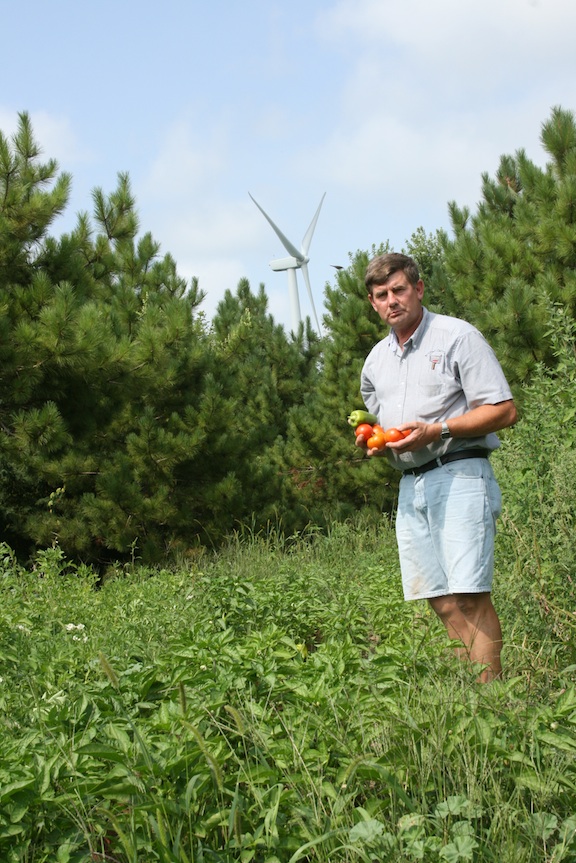 Gerry Meyer in his garden, turbine #4 in background
Gerry Meyer in his garden, turbine #4 in background
Wind Turbine Sounds Spur Health Complaints, Force Residents to Move
SOURCE: Acoustic Ecology Institute
The spread of wind turbines into quiet rural areas is leading to increasing complaints that they make more noise than residents were led to believe.
While simple annoyance and sleep disturbance are the most common effects, in some cases, nearby residents are reporting health problems that they associate with the presence of the turbines, leading some to move from their homes.
Not long after wind turbines began to spin in March near Gerry Meyer’s home in Wisconsin, his son Robert, 13, and wife, Cheryl, complained of headaches.
Cheryl also sometimes feels a fluttering in her chest, while Gerry is sometimes nauseated and hears crackling.
The nearest turbine is 1,560 feet from Meyer’s house. His dismay over an energy source he once thought was benign has made the retired mailman, 59, an activist. He travels the state warning communities considering wind farms to be wary.
“I don’t think anyone should have to put up with this,” says Meyer, who compares the sound to a helicopter or a jet taking off.
In Canada, Helen and Bill Fraser initially supported the nearby wind farm in Melancthon, Ont. One turbine sat close to the Fraser’s kitchen window. “We thought, more green energy, this is great,” Helen told CTV News. However, Helen says she developed headaches, body aches and she had trouble sleeping. The dog began wetting the floor at night.
“There were nights I was lying in bed and my heart would beat to the pulse of the turbine. It was an uneasy feeling,” Helen said.
Ernie Marshall at first supported the wind farm that was placed near his home near Goderich, Ont. However, he also says that once the turbines got rolling, his health began to suffer.
“I had problems with my heart, with my eyes, my digestive system,” Marshall told CTV News. “It traumatizes your whole body.”
Some affected residents can only sell their homes and move away. The Frasers left their home of 32 years and moved to nearby Shelburne, Ont. They say their symptoms have, for the most part, vanished.
Ernie Marshall moved to the town of Seaforth, Ont., which is several kilometers away from the turbines near his former home. “I had to get out or I wouldn’t be standing here talking to you,” Marshall said.
Dr. Nina Pierpont, a pediatrician in upstate New York, has interviewed dozens of people who live near windmills in Canada, the United States and Europe. Her [recently] released book, Wind Turbine Syndrome, documents the litany of health problems experienced by some people who have wind farms near their homes.
Some early findings suggest that wind turbines create a high intensity, low frequency sound that may have an effect on the body. Not only can the sound potentially cause debilitating illness.
Some researchers believe that the vibrations the sound causes in the inner ear may lead to vibro-acoustic disease, which can cause dizziness, nausea and sleep disturbances. However, officials with the Canadian Wind Energy Association point to a handful of studies they say prove that windmills lead to few, if any, adverse health effects.
“We know there have been complaints about health impacts of wind turbines,” Sean Whittaker of the Canadian Wind Energy Association told CTV News. “On the other hand, we know there are some 10,000 turbines installed across North America and complaints have been relatively few.”
The issue has not just put experts at odds. Communities across North America are divided between residents who say local windmills have made them sick and their neighbors who don’t believe them.
“Everyone was calling me a liar,” Ernie Marshall said. “It don’t matter who you talk to. You bring ‘em out here and they’ll say that noise don’t bother us. Sit there for a week under that and listen to it and see what it does to your body.”
The inconsistencies in the early research, coupled with the fact that some residents who live near wind turbines complain of such a wide array of symptoms, are evidence that further study is needed to determine if Wind Turbine Syndrome is a problem, how big of one and what should be done, experts say.
“Depending on your distance you’ll have 30, 40, 50 per cent of people who are troubled, but not 100 per cent,” Dr. Robert McMurtry of the University of Western Ontario told CTV News. “That’s why it’s important to do these studies to see just how many are troubled and how real it is.”
TORONTO INTERNATIONAL FILM FESTIVAL: WINDFALL
By Howard Feinstein
“Then I started to meet some people from Meredith. A lot of them—artists, writers—go up there to be alone. This topic pulled them out of their shells to work together.”
So began Israel’s foray into directing, Windfall, an excellent documentary–a real discovery in Toronto–which is as much a study of a small rural community torn asunder as it is of the pros and cons of the massive turbines which energy salesmen were pitching to the locals.
For a price, the residents could agree to let them build the massive structures on their land. In a town with no zoning, the reps from an energy outfit in Ireland anticipated huge profits.
Even though Delaware County is one of the five poorest in New York State, other towns were not as easily seduced as some of the homeowners in Meredith, who signed contracts for a relative pittance.
Most of those who agreed had been born there, former dairy farmers hard it by the economy and changes in agrarian commerce. Most of the opposition was comprised of former or current residents of New York City, whom the lifetimers, according to Israel, call “flatlanders.”
The feud became bitter, culminating in a new slate of candidates vying in a coming municipal election for the offices long held by lifers. The lines were drawn; the debate became more and more bitter.
“I don’t think it was like that before the subject came up,” says Israel. “There are no chi-chi boutiques there; it’s not that kind of town. It seemed like everyone got along. This subject pushed people into corners.” The lead-up to the election gives the film rhythmic, suspenseful momentum.
Israel interviews her subjects outdoors, capturing a natural, unforced bucolic backdrop enriched by a plucky, country-tinged score.
Most of them have interesting back stories that provide digressive texture. Stop-motion animator Dean Modino brings alive maps, photographs, and, building up over the course of the film’s running time, the wind turbines themselves, already cinematic by design.
As one relative newcomer to Meredith says, “These are not the 50’ windmills of Don Quixote. These are 400’ high.” Each blade is 130’ long, weighs seven tons, and moves at 150 miles per hour. The whishing noise is non-stop, and much worse when it rains.
The well-informed interviewees who stood against the turbines articulate their positions, as do several environmentalists and energy experts.
When erected too near peoples’ homes, the turbines wreak emotional and psychological havoc on the residents. Tug Hill, in Lowville, New York, is one place where 400 of them were built, and the townspeople have found them oppressive.
One subject says that to be built and maintained, they require fossil fuels, and it is questionable if the amount that they put back into the grid is worth the effort. Green and wind energy may be mutually exclusive terms.
Israel is the first to say she does not offer definitive answers. “I’m just asking people to look into it more. I know there’s a lot going on in Europe, even in Denmark. People there are asking if there really is that much power coming from the wind turbines.
“We want desperately to have easy answers. Then all you have to do is send in some money and someone else can take care of it.”
9/10/10 Director's cut: Documentary "Windfall" : A darker shade of 'green'
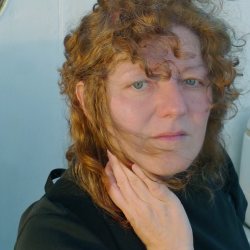
WINDFALL" DIRECTOR LAURA ISRAEL UNCOVERS THE DARK SIDE OF ALTERNATIVE ENERGY
SOURCE: Cinemablend.com
September 10, 2010
By Katey Rich
Laura Israel had been working for as a film editor for decades when the subject that inspired her to direct her first film quite literally showed up on her doorstep.
The New York-based filmmaker had spent years going up to a cabin in remote Meredith, New York without getting to know her neighbors, but when several people in town signed contracts allowing an industrial company to place wind turbines on their property, and several others opposed it, Israel found herself caught in a local political issue that resonated across the country.
The resulting documentary is Windfall, which premieres this week at the Toronto International Film Festival.
In telling the story of Meredith Israel explores the largely hidden downside of allowing wind energy corporations to stake out land in American communities, installing 400-foot high wind turbines so near peoples' homes that residents complain of headaches and respiratory problems, not to mention the diminished property values and general noise of a giant turbine so near one's home.
As the residents in Meredith duke out their concerns at town hall meetings, Israel and her crew also take us to neighboring Tug Hill, where dozens of wind turbines have already changed that small town forever.
Israel doesn't claim to have all the answers about alternative energy and how to reduce our dependence on oil, but says that with Windfall she wants to inspire people to ask questions and look beyond the easy equation that "wind energy= clean energy= good."
I talked to Israel about what inspired her to tell the story, how she's been in touch with other communities also looking for more answers about wind energy, and how making this film got her more involved with her neighbors than she previously expected. Windfall premieres this Friday, September 10th at TIFF. [Toronto Interational Film Festival]

How did this story wind up coming to you? It's obvious you feel passionately about it.
I actually own a little cabin in the woods up in Meredith. I started reading little articles in the local paper there, just mentioning "when the wind energy comes," or "when we get turbines."
I decided, oh, I would love to have a wind turbine. I started looking into it a little further, and I was really taken aback by what I found.
Because of the complexities of the issues, I thought it would make a good topic for a short film. When we started filming I realized it was much bigger topic than I thought.
Did you know most of the people we see in this movie before you started making the film?
No. I had this cabin and I went there to just be alone. When they started to raise concerns, I thought "They seem like perfectly reasonable people. "
If that's the case, and they're also raising concerns about it, there must be more of the story. Once we start looking into it, wind energy has so many different facets-- the financial, the political, the engineering. The film started to get longer.
When you start making the film, you can't participate in the issue the way you would have. How did you adjust to that?
The thing is, the issue really changed a lot. I really tried to keep the whole film from the town's point of view. We find out about things as they find out about things. That's how it happened.
The people speaking in favor of wind energy are all people based on the local level, and you don't have anyone from the wind companies themselves. Was that a deliberate choice?
Because I did it from the town's point of view, if you notice, there are no wind companies at the meetings answering questions.
That's one of the reasons why the wind people aren't in the film. They get contracts, and all of a sudden they are really scarce, and I wanted to represent that in the film, their absence.
The film isn't an expose about wind, it's more like the experience of the town. People who live among turbines are trying to get the word out about problems they're having, and I wanted to give voice to them, rather than the wind companies.
It looks like you've been in touch with a lot of people in other cities dealing with wind.
Yeah, even after we just put up the website and the trailer, I started to get a lot of requests for the film. I felt really motivated to get the film out to Toronto, and out to communities that want more information. I have been approached by quite a few people. People have been telling me their stories, and it's very moving.

Do you have a particular favorite alternative energy solution, as a viable solution that isn't industrial wind power?
I don't think the answer is going to be simple. It's something that we as a larger community have to work out the same way that Meredith did, which is really sitting down and trying to figure out, well, how are we going to negotiate something like that.
A lot of people would like to think that this is the answer, let's just do this. I think it's going to be a lot more difficult than that.
Communities being able to decide their future, and decide how they can get power instead of centralizing it among all these really big international corporations-- personally I would rather see that. I think it's something that we all have to decide and try and work toward.
Is it valid to say that wind is the lesser of the evils for energy sources?
I don't want to lull people into thinking that I have all the answers, or that the film is going to give them all the answers. I'm just trying to ask people to look closer at it. Gordon says in the film, "Ask questions, do your homework."
I also think there's a bit of corporate accountability that should be brought up here. If people are having trouble living near these things, do some studies.
There are lot of people having trouble living near the low-frequency sound, and I think they're being ignored.
And if wind turbines are killing bats in really large numbers, then let's study that.
In towns, residents shouldn't be intimidated by these corporations when they want to come in and do the development.
Public officials who have a financial interest should not be making decisions on turbines. People should have unbiased information available to them so they can be part of the process of the future of their communities.
9/8/10 No need to read between the lines--
 News articles about wind turbine noise and health
News articles about wind turbine noise and health
Milner, Catherine (January 25, 2004). Telegraph. “Wind farms ‘make people sick who live up to a mile away’”.
Keller, James (May 13, 2006). Hamilton Spectator. “Family says turbine vibrations made them ill enough to move”.
Kriz, Kathy (October 12, 2006). WHAM-TV. “Could Wind Turbines Be A Health Hazard?”.
Chronicle Herald (August 27, 2007). “Quietly sounding alarm; Forced from home after noise from wind farm turbines made family sick, d’Entremont telling others his story”.
St. James, Janet (July 29, 2008). WFAA-TV. “Neighbors claim wind turbine makes them ill”.
CTV (September 28, 2008). “Wind turbines cause health problems, residents say”.
Keen, Judy (November 3, 2008). USA Today. “Neighbors at odds over noise from wind turbines”.
Tilkin, Dan (November 14, 2008). KATU-TV. “Wind farms: Is there a hidden health hazard?”.
Sudekum Fisher, Maria (February 3, 2009). Associated Press. “NW Missouri man sues Deere, wind energy company”.
Takeda, Tsuyoshi (February 6, 2009). Asahi Shimbun. “Something in the Wind as Mystery Illnesses Rise”.
Blaney Flietner, Maureen. Bobvila.com. “Green Backlash: The Wind Turbine Controversy”.
Nelson, Bob (March 2, 2009). Morning Show, KFIX. “Wind farms: Interview of Malone and Johnsburg residents”.
Mills, Erin (March 8, 2009). East Oregonian. “Loud as the wind: Wind tower neighbors complain of noise fallout”.
Miller, Scott. A-News, CTV Globe Media. “Wind Turbines Driving People From Their Homes”.
Tremonti, Anna Maria (April 14, 2009). The Current, CBC Radio One. “Wind Turbines: Health”.
CBC News. April 14, 2009. “Wind turbines causing health problems, some Ont. residents say”.
Buurma, Christine (April 21, 2009). Wall Street Journal. “Noise, Shadows Raise Hurdles For Wind Farms”.
CTV Toronto (April 22, 2009). “Reports of wind farm health problems growing”.
Canadian Press (April 23, 2009). CBC News. “Formal study needed into health effects of wind turbines, doctor says”.
Miller, Scott. A-News, CTV Globe Media. “Daughter’s Earaches Blamed On Wind Farm”.
Epp, Peter (May 5, 2009). “Survey points to health woes arising from wind turbines”.
Mayne, Paul (May 7, 2009). Western News. “Is public’s health blowing in the wind?”.
Delaney, Joan (May 13, 2009). The Epoch Times. “Wind turbines blamed for adverse health effects”.
Alteri, Beth (May 15, 2009). WLBZ2. “Does wind turbine noise affect your sleep or health?”.
Hale, Caleb (May 23, 2009). Southern Illinoisan. “Health can be a key issue when living near wind farm”.
Hessling, Kate (June 4, 2009). Huron Daily Tribune. “Solutions sought for turbine noise”.
Boles, Stephen (June 7, 2009). Red, Green and Blue. “Wind Turbine Syndrome: Are wind farms hazardous to human health?”.
Kart, Jeff (June 11, 2009). Bay City Times. “Wind turbine noise is rattling some residents in Michigan’s Thumb”.
Walsh, Bill (June 19, 2009). WNEM. “Wind Farms Ruining Quality of Life?”.
Hundertmark, Susan (June 24, 2009). Lucknow Sentinel. “St. Columban residents get informed on wind turbine health concerns”.
Yoshida, Noriyuki; and Yasuda, Koichi (July 1, 2009). Daily Yomiuri. “Wind power has its own environmental problems”.
ABC News (July 15, 2009). “Wind turbine noise ‘forces’ couple out”.
Pagano, Margareta (August 2, 2009). The Independent. “Are wind farms a health risk? US scientist identifies ‘wind turbine syndrome’”.
Martin, Daniel (August 2, 2009). Daily Mail. “Living near a wind farm can cause heart disease, panic attacks and migraines”.
Stewart, Linda (August 3, 2009). Belfast Telegraph. “Is it dangerous to live close to wind turbines?”.
Woodrow, Shane (August 6, 2009). WIN TV. “Windfarm Research”.
Anne Ravana (August 7, 2009). Maine Public Broadcasting Network. “Discontent of Mars Hill Residents Leads to Lawsuit Against First Wind”.
Baca, Nathan (August 11, 2009). KESQ. “Migraine, Wind Turbine Connection Still Being Examined”.
Lynds, Jen (August 12, 2009). Bangor Daily News. “Mars Hill windmills prompt civil lawsuit”.
A Current Affair (August 14, 2009). Nine-MSN. “Electricity nightmares”.
Wind Concerns Ontario (August 16, 2009). “Wind Victims Gagged and Silenced in Ontario”.
ABC News (August 18, 2009). “Pyrenees Shire questions wind farm noise”.
Wilson, Lauren (August 22, 2009). The Australian. “Farmers flee as turbines trigger despair”.
Wilson, Lauren (August 24, 2009). The Australian. “No relief for land owners affected by wind farms”.
ABC News (August 28, 2009). “Govt urged to probe wind farm illness claims”.
ABC News (September 4, 2009). “Qld noise experts to test Waubra wind farm”.
Hall, Cheryl (September 4, 2009). Stateline Victoria, ABC. “Wind Farms causing head spins”.
Reading, Lyndal (September 7, 2009). Weekly Times. “Anger over wind turbine noise”.
Chatham Daily News (September 22, 2009). “Wind turbines still a problem for some”
Brown, Judy (September 30, 2009). Farm Country. “Wind turbines generate health, farming concerns”.
Stevens, Kim (October 15, 2009). The Courier. “Health check at Waubra wind farm”.
Whittle, Julian (October 22, 2009). News & Star. “Living near turbines is ‘mental torture’, Carlisle inquiry told”.
Vivian, Richard (November 12, 2009). Orangeville Banner. “Answers definitely not blowing in the wind”.
Vivian, Richard (November 16, 2009). Orangeville Banner. “No proven link exists between wind turbines, health problems”.
Vivian, Richard (November 19, 2009). Orangeville Banner. “MOE pledges ongoing research on turbines, health”.
CBC News (November 18, 2009). “Wind power health effects queried by municipal group”.
Annis, Robert (November 19, 2009). Indianapolis Star. “Boone County looking into wind farm health fears”.
Crosby, Don (November 20, 2009). Owen Sound Sun Times “Bruce seeks wind turbine health study”.
Lam, Tina (November 24, 2009). Detroit Free Press “Living by wind farms no breeze, some say”.
Yomiuri Shimbun (November 29, 2009). “Govt to study effects of wind farms on health”.
Leake, Jonathan, and Byford, Harry (December 13, 2009). Sunday Times. “Officials cover up wind farm noise report”.
White, Leslie (December 24, 2009). Weekly Times. “Report critical of wind farms”.
Braithwaite, Chris (December 30, 2009). Chronicle. “Wind tower neighbor bought out for health reasons”.
Schliesmann, Paul (January 16, 2010). Whig-Standard. “Wind turbines: Expert says people are suffering health problems from being too close to structures”.
Ito, Aya; and Takeda, Tsuyoshi (January 19, 2010). Asahi Shimbun. “Sickness claims prompt study of wind turbines”.
Squair, Sylvia (February 4, 2010). “Throwing Caution to the Wind”.
Hall, Cheryl (February 19, 2010). Stateline Victoria, ABC News. “Claims of wind farm illness”.
Bryce, Robert (March 1, 2010). Wall Street Journal. “The Brewing Tempest Over Wind Power”.
ABC News (March 4, 2010). “Govt to investigate wind farm complaints”.
Fox Business (March 4, 2010). “Wind Farms Causing Health Problems?”.
Gray, Louise (March 6, 2010). Telegraph. “Noise complaints about one in six wind farms”.
Martin, Steve (March 16, 2010). Ballarat Mornings, ABC Victoria. “Wind Turbine Syndrome with Dr Nina Pierpont”.
Snyder, Paul (April 1, 2010). Daily Reporter. “Landowners sue Invenergy over Forward Wind Energy Center”.
Spolar, Matthew (April 12, 2010). Concord Monitor. “Effects of turbines in question”.
Kottke, Colleen (April 18, 2010). Fond du Lac Reporter. “Oakfield couple files PSC complaint over wind farm”.
Roper, Matt (April 19, 2010). Daily Mirror. “Couple driven out by noisy wind turbines sue for £380,000″.
BBC News (April 27, 2010). “Lincolnshire windfarm rejected to help autistic boys”.
Oike, Yuki Tsuruta (April 30, 2010). “Japanese conference against big wind”.
Mulholland, Jessica (March 1, 2010). Governing. “Are Wind Farms a Health Risk?”.
Snyder, Paul (May 6, 2010). Daily Reporter. “Wind farm property sells at sheriff’s sale”.
O’Gorman, Josh (May 7, 2010). Rutland Herald. “Hospital hosts wind debate”.
Craddock, Chelsea (May 16, 2010). Watertown Daily Times. “Hospital shows off balance center”.
De Long, L. Sam (May 26, 2010). Watertown Daily Times “Another health problem caused by turbines”.
AAP (May 27, 2010). Herald Sun. “Sick residents claim wind farm ‘torture’”
WNEM (May 28, 2010). “Homeowners File Lawsuit Over Wind Turbines”.
Weaver, Alex (May 29, 2010). The Standard. “An ill wind blows in”.
McConville, Christine (June 2, 2010). Boston Herald. “Falmouth wind-turbine noise has local residents whirling”.
Simpson, Barbara (June 2, 2010). Delhi News-Record. “A quiet room of their own: Residents impacted by wind turbines sleep in Delhi”.
Sellars, Paul (June 3, 2010). Weekly Times. “Wind turbine illness claims”.
Lazzaro, Kellie (July 5, 2010). ABC News. “Residents reject wind farm health findings”.
Australia.to News (July 27, 2010). “Family First Senator seeks enquiry into health effects of wind farms”.
Hugus, Elise R. (July 27, 2010). “Bylaw in the Works to Regulate Turbine Noise”.
